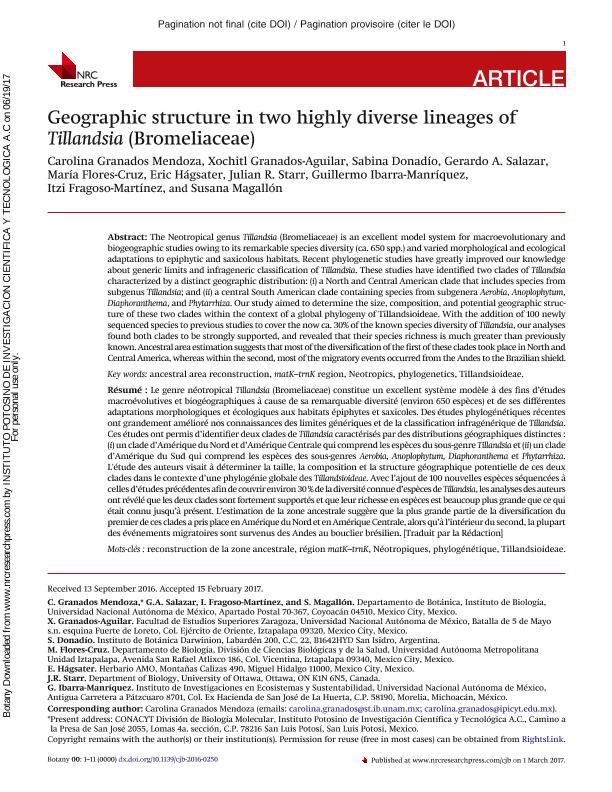Artículo
The Neotropical genus Tillandsia (Bromeliaceae) is an excellent model system for macroevolutionary and biogeographic studies owing to its remarkable species diversity (ca. 650 spp.) and varied morphological and ecological adaptations to epiphytic and saxicolous habitats. Recent phylogenetic studies have greatly improved our knowledge about generic limits and infrageneric classification of Tillandsia. These studies have identified two clades of Tillandsia characterized by a distinct geographic distribution: (i) a North and Central American clade that includes species from subgenus Tillandsia; and (ii) a central South American clade containing species from subgenera Aerobia, Anoplophytum, Diaphoranthema, and Phytarrhiza. Our study aimed to determine the size, composition, and potential geographic structure of these two clades within the context of a global phylogeny of Tillandsioideae. With the addition of 100 newly sequenced species to previous studies to cover the now ca. 30% of the known species diversity of Tillandsia, our analyses found both clades to be strongly supported, and revealed that their species richness is much greater than previously known. Ancestral area estimation suggests thatmost of the diversification of the first of these clades took place in North and Central America, whereas within the second, most of the migratory events occurred from the Andes to the Brazilian shield. Le genre néotropical Tillandsia (Bromeliaceae) constitue un excellent système modèle a` des fins d’études macroévolutives et biogéographiques a` cause de sa remarquable diversité (environ 650 espèces) et de ses différentes adaptations morphologiques et écologiques aux habitats épiphytes et saxicoles. Des études phylogénétiques récentes ont grandement amélioré nos connaissances des limites génériques et de la classification infragénérique de Tillandsia. Ces études ont permis d’identifier deux clades de Tillandsia caractérisés par des distributions géographiques distinctes : (i) un clade d’Amérique du Nord et d’Amérique Centrale qui comprend les espèces du sous-genre Tillandsia et (ii) un clade d’Amérique du Sud qui comprend les espèces des sous-genres Aerobia, Anoplophytum, Diaphoranthema et Phytarrhiza. L'étude des auteurs visait a` déterminer la taille, la composition et la structure géographique potentielle de ces deux clades dans le contexte d’une phylogénie globale des Tillandsioideae. Avec l’ajout de 100 nouvelles espèces séquencées a` celles d’étudesprécédentes afin de couvrir environ 30% de la diversité connue d’espèces deTillandsia, les analyses des auteurs ont révélé que les deux clades sont fortement supportés et que leur richesse en espèces est beaucoup plus grande que ce qui était connu jusqu’a` présent. L’estimation de la zone ancestrale suggère que la plus grande partie de la diversification du premier de ces clades a pris place en Amérique du Nord et en Amérique Centrale, alors qu’a` l’intérieur du second, la plupart des événements migratoires sont survenus des Andes au bouclier brésilien
Geographic structure in two highly diverse lineages of Tillandsia (Bromeliaceae)
Granados Mendoza, Carolina; Granados Aguilar, Xochitl; Donadío, Sabina ; Salazar, Gerardo A.; Flores Cruz, María; Hágsater, Eric; Starr, Julian R.; Ibarra Manríquez, Guillermo; Fragoso Martínez, Itzi; Magallón, Susana
; Salazar, Gerardo A.; Flores Cruz, María; Hágsater, Eric; Starr, Julian R.; Ibarra Manríquez, Guillermo; Fragoso Martínez, Itzi; Magallón, Susana
 ; Salazar, Gerardo A.; Flores Cruz, María; Hágsater, Eric; Starr, Julian R.; Ibarra Manríquez, Guillermo; Fragoso Martínez, Itzi; Magallón, Susana
; Salazar, Gerardo A.; Flores Cruz, María; Hágsater, Eric; Starr, Julian R.; Ibarra Manríquez, Guillermo; Fragoso Martínez, Itzi; Magallón, Susana
Fecha de publicación:
07/2017
Editorial:
National Research Council Canada-NRC Research Press
Revista:
Botany
ISSN:
1916-2790
Idioma:
Inglés
Tipo de recurso:
Artículo publicado
Clasificación temática:
Resumen
Archivos asociados
Licencia
Identificadores
Colecciones
Articulos(IBODA)
Articulos de INST.DE BOTANICA DARWINION (I)
Articulos de INST.DE BOTANICA DARWINION (I)
Citación
Granados Mendoza, Carolina; Granados Aguilar, Xochitl; Donadío, Sabina; Salazar, Gerardo A.; Flores Cruz, María; et al.; Geographic structure in two highly diverse lineages of Tillandsia (Bromeliaceae); National Research Council Canada-NRC Research Press; Botany; 95; 7; 7-2017; 641-651
Compartir
Altmétricas



